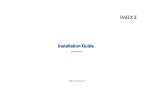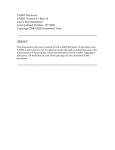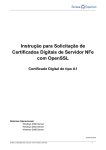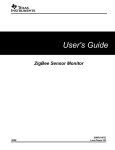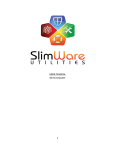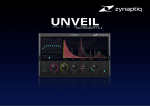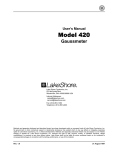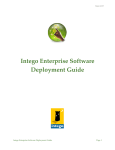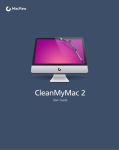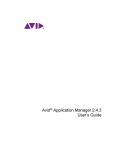Download SMEDGE Installation Guide
Transcript
Smedge Installation Guide Smedge 2010 © 2004 - 2010 Überware™ Table of Contents TABLE OF CONTENTS 2 WELCOME TO SMEDGE! 3 SOME DETAILS ABOUT SMEDGE WINDOWS OS-X LINUX INSTALLING THE LICENSE GETTING OTHER PROGRAMS TO WORK WITH SMEDGE WORKING CROSS-PLATFORM Smedge 2010 Installation Guide 3 4 5 6 7 8 9 RUNNING SMEDGE AUTOMATICALLY MACHINE ROLES INSTALLING USING SMEDGEGUI INSTALLING BY THE SYSTEM 11 11 12 13 UPGRADING SMEDGE 3 14 TROUBLESHOOTING 15 UNINSTALLING SMEDGE 17 © 2004 - 2010 Überware™ 2 Welcome to Smedge! Smedge is a system that allows you to control a wide variety of other software packages on multiple machines at the same time. It provides accurate and reliable queuing and distribution of work on multiple devices. It is completely platform independent and flexible enough to support any type of work process you can imagine. Some details about Smedge Smedge works in a “client/server” architecture. Note that every machine can be both client and server, and that the details of that architecture are handled automatically by the program. However, there are some fundamental prerequisites for Smedge to operate correctly. Specifically, machines must be connected to a network, and machines must be able to connect to each other directly through TCP/IP. That machines do not have to be able to find each other by name for Smedge to work, but some operations may be limited if they cannot. Ask your network administrator if you have any questions about your network. If a machine has a software firewall installed, that firewall must either be disabled or configured to allow Smedge component applications to communicate. The Master can configure the port it listens on but all other clients get their port determined automatically by the Operating System, so you must open the firewall by application not by port. Please note that the products that Smedge can control are distributed and licensed separately from Smedge. For installation or licensing of these products, please contact your support agent or the technical support facilities for that software product. We recommend using a file server to use for storing your projects and associated source, texture, data and render files. Configuring a file server is beyond the scope of this manual. There are many resources on the Internet for setting up file servers, or you can consult an IT professional or hardware reseller to configure your file server and networking optimally for your needs and budget. Smedge does not copy any files around as part of its processing, though it is possible to extend the system to copy files if you want to configure a pipeline to do so. All trademarks are the property of their respective owners. Smedge 2010 Installation Guide © 2004 - 2010 Überware™ 3 Windows Follow these steps to install Smedge on a Windows machine running Windows 2000 or later 1. Download the msi file. 2. If it is not opened automatically, double click the msi file to start the installation process. 3. Run the Smedge program from the Start menu or the desktop icon to start Smedge. If you want to install run Smedge from a network location, be sure to install the Microsoft Visual C++ runtime library (x86). You can download this from the Microsoft web site: http://www.microsoft.com/DOWNLOADS/details.aspx?FamilyID=9b2da534-3e03-4391-8a4d-074b9f2bc1bf You can also download Smedge as a ZIP archive. This archive does not include the Microsoft Visual C++ runtime library. Download from the link above if you need it. Smedge 2010 Installation Guide © 2004 - 2010 Überware™ 4 OS-X Follow these steps to install Smedge on a Macintosh computer running OS-X 10.4 or later 1. Download the dmg file. 2. If it is not automatically mounted, double click the dmg file to mount the distribution volume. 3. Drag the Smedge application icon to the folder where you want to install it (for example to /Applications) 4. Double click the Smedge icon to start Smedge. The Smedge program files and libraries on Macs are entirely self contained in the Smedge.app bundle (the application icon you dragged). You can access the individual components, including the command line utilities, virtual modules and module INI files using Terminal or by using the Finder's View Package Contents command. You can run the application from any folder. Smedge 2010 Installation Guide © 2004 - 2010 Überware™ 5 Linux Follow these steps to install Smedge on a Linux computer 1. Download the archive file 2. If it is not expanded automatically, expand the downloaded archive. 3. Start Smedge by typing the path to where you downloaded Smedge, like this Downloads/Smedge/SmedgeGui You can create an alias, add a symbolic link into your binary path, add the Smedge program folder to the default PATH environment variable, and so forth. Smedge currently does not automatically integrate with the Linux distributions' graphic front ends at this time, though the GUI components should work normally on any recent GTK 2 distribution. Smedge 2010 Installation Guide © 2004 - 2010 Überware™ 6 Installing the License Once you have installed at least the single Master machine, you can install the license code. You can install the code from any machine, on any platform, that is currently connected to the Master. You will only need to install a single code no matter how many machines you have. Follow these steps to install the license: 1. Start SmedgeGui. It does not matter which machine you use, as long as it can connect to the Master. 2. Make sure you are in Administrator Mode 3. Choose System > System Commands > Submit License… 4. Copy the Master ID code you see into the field on your Uberware.net account generate license page. page 5. Paste the resulting code back into the License Code field. 6. Click OK. Smedge 2010 Installation Guide © 2004 - 2010 Überware™ 7 Getting other programs to work with Smedge Smedge can control many third-party applications if they provide a command line based interface. For example, the Maya Product supports rendering of Maya scenes using a common command line interface. Some of these Products may require additional support to get operating. Besides basic issues such as installation and licensing of the third party application, one of the most common issues is ensuring that Smedge is able to find the command line executable to use the system. Many products in Smedge can try to find the exectuable in a known default installation location, and can often find the latest version of an application if multiple versions are installed. When Smedge is started on a machine, it checks the paths it knows about, looking for new installations. Note, however, that once it has detected an installed version, it will not update that version if you later install an updated version of that product. You will need to manually update the version like below. If a Smedge Product uses a command line executable, that Product will have a way to set the path to the executable manually. The most common way is to set this as an option for that Product on the Engine, by following these steps: 1. Select all of your Engines in SmedgeGui 2. Choose Engine > Configure Product Options… 3. Select the Product you wish to configure, for example “Maya”. 4. Put the desired path into the Path to the Executable field For example, the path to the Maya 2010 executable on OS-X is usually: /Applications/Autodesk/maya2010/Maya.app/Contents/bin/Render 5. If desired, repeat the steps 3 and 4 for any other Products you may need. 6. You may want to save a full configuration as a default you can apply to have all settings configured from that default automatically by pressing the Reset to Default button. Alternatively, you can save the full configuration as a Preset, which you can the apply to new machines to set them up quickly with standardized settings. 7. Click OK to have the change committed to every Engine you had selected. Smedge 2010 Installation Guide © 2004 - 2010 Überware™ 8 Working Cross-Platform When you are mixing multiple platforms of Smedge together, any Smedge component application can be run on any platform and they all interconnect together. However, because each platform handles access to network resources differently, there are some additional steps that are required for completely transparent multi-platform operation. The key to making Smedge work across multiple platforms is to tell the system how to translate the different access systems that you are using on your site. For example, if your project files are generally kept on a file server that is mounted on a Windows drive letter, you would tell Smedge the drive letter that you are using on Windows, and the mount point on a Unix file system that a Linux or OS-X machine uses to access that same file server. To configure path translations, follow these steps: 1. Start SmedgeGui. It does not matter which platform you use, or which machine you use. Any machine that has Smedge installed can allow you access to configure the system. However, you must be in Administrator Mode. This command is available in the System menu. 2. Choose System > System Commands > Configure Master… This opens the Master configuration dialog box. You can get more information about this dialog box in the User Manual included in the Smedge distribution, or available on our website: http://www.uberware.net/smedge3/docs.php 3. Click on the Path Translations tab. 4. Click the Add Button 5. The three fields listed here are the “root” part of the file path, or the leftmost part, which indicates which physical volume on which the file resides. For example, on Windows, the root is usually a drive letter or UNC path: X:\Projects\MyJob\scenes\MyScene.fil \\Server\Drive\Projects\MyJob\scenes\MyScene.fil Each platform has its own syntax for identifying file systems. For example, on a mac, this same file may be accessed with this path: /Volumes/FileServer/Projects/MyJob/scenes/MyScene.fil The Path translations are the parts of the two names above that are different, the underlined part, starting at the leftmost character. See the following examples: Smedge 2010 Installation Guide © 2004 - 2010 Überware™ 9 In this example, the mapped drive X: on Windows will be translated to /mnt/Server on Linux and /Volumes/FileServer on OS-X. . You can leave the field for any platform you do not use blank. This example is how it can look if you only use Windows and OS-X machines. It also shows a UNC path instead of a drive letter. Although these screen captures were made on Windows, you could use any platform to make these changes. 6. Click OK to add the translation to the list of translations and close the small Path Translations adding dialog. 7. Click OK again to close the Configure Master dialog and submit the changes to the Master. Some notes about working cross platform Smedge can only translate the paths that it actually operates with. This means, paths that are submitted by the user as part of the Job information, or paths that the Smedge software itself was able to detect from the products it controls. However, any paths that may be embedded into the work's source files (like texture files referenced in a scene or source clips from a project) are not accessible to Smedge, and will not be translated. In other words, you can render a Maya scene you created on Windows and Smedge will translate the path to that scene file if you have Macs that can render as well. However, if that Maya scene file references a file texture with an absolute path (not relative to the scene file or to the Maya project), you may see unexpected results if that file cannot be found with the same absolute path on every node of your network (whether the same platform or not). Many Products that Smedge controls are smart about locating referenced files when rendered from a shared file server. However, if you experience unexpected results in your renders, one of the first things to check is that your source files are accessible by all nodes when accessed through the file server. Smedge 2010 Installation Guide © 2004 - 2010 Überware™ 10 Running Smedge automatically Machine Roles Smedge 3 defines 3 roles for a computer: Master This is the machine that will manage the system. This machine should not also be both an Engine and a File Server for your network if you can avoid it. Engine This is a machine that does the work. Workstation This is any machine that has Smedge installed, if it is not performing one of the other roles. When you run Smedge normally, it automatically starts the Master and the Engine on your machine when you start the GUI, and stops them when you stop the GU, making each machine able to fullfill any role at any time. This is a simplistic setup that makes it easy to use, but can degrade performance in large deployments by increasing the amount of network overhead that Smedge uses. Additionally, many high performance rendering installations want to optimize the amount of system overhead, running as few processes as necessary. Note, however, that running Smedge automatically has disadvantages as well. The most common concerns are the user account that is used to run the process and how the process accesses the shared resources that are required for doing the work. You should pick a user account that is appropriate for running the SmedgeEngine daemon. Using a system administrator or root user account, which is the default for Linux and OSX, is dangerous, and should be avoided. Note that the default account on Windows is so unprivileged, however, that it cannot mount network drives as drive letters, which can be a problem for Windows users. The details of making your file server available to a service or daemon is beyond the scope of this document. See your network administrator or IT department. At an absolute minimum, to make a working Smedge network you need only a single machine running SmedgeMaster, and you only need the SmedgeEngine process on each machine you want to do work. You can run the other shell components on as many or as few machines as you wish. If you have redundant Master systems, they will “mirror” each other, and can take over as Master automatically if needed. Smedge 2010 Installation Guide © 2004 - 2010 Überware™ 11 Installing using SmedgeGui The easiest way to install Smedge components as services is to use the commands for doing so from the SmedgeGui System menu: System > Components > Install and Start the Engine Service This will install the Engine component, making the machine available to do work automatically from the moment it boots until the moment it shuts down, without a user needing to be logged in. There are minor differences on how this works on each platform: Mac You will have the opportunity to set the user account and any extra parameters that you want, and you will have the opportunity to authenticate as an administrator in order to install and start the service. Windows You will have the opportunity to set the user account and any extra parameters that you want, but you must be running SmedgeGui as an administrator to successfully install the service. Linux You will not have an opportunity to set the user account or extra parameters and you must be running SmedgeGui as a superuser. You may see your machine go offline for a bit in the SmedgeGui while you do this. It should come back within a minute or two. System > Components > Install and Start the Master Service This will install the Master component, making the machine available to administer the system automatically from the moment it boots until the moment it shuts down, without a user needing to be logged in. There are minor differences on how this works on each platform: Mac You will have the opportunity to set any extra parameters that you want, and you will have the opportunity to authenticate as an administrator in order to install and start the service, but you cannot override the user account. Windows You will have the opportunity to set any extra parameters that you want, but you must be running SmedgeGui as an administrator to successfully install the service and you cannot override the user account. Linux You will not have an opportunity to set the user account or extra parameters and you must be running SmedgeGui as a superuser. Smedge 2010 Installation Guide © 2004 - 2010 Überware™ 12 You may see your machine get disconnected from the Master while you do this. It should come back within a minute or two. Installing by the system On Macs, there are a series of utilities in the Utilities folder of the distribution for installing, removing, starting and stopping the daemon components. These scripts are self descriptive about what they do, and take care of 100% of the work, including being able to set the user account, extra parameters and authenticate as a system administrator. On Windows, there are several batch files in the Utilities folder, along with some supporting programs and data files that are used by the batch files to do their work. The batch files will do all of the work, including optionally creating a default Smedge local user account for your system to use. You must be run the batch files as an administrator for them to work correctly. On Linux, there are two shell scripts in the Utilities folder that do the work. Run these scripts as a superuser to install the daemons. If you don't supply an argument, it will install (or remove) the engine daemon by default. Otherwise, supply the argument master to install or remove the Master as a daemon or the argument engine to install or remove the Engine as a daemon. Other capabilities Each platform has its own peculiarities about running applications automatically in the background. For more information, see your system documentation, your system administrator or your IT department. You can also contact your software or hardware support vendor or Uberware technical support Smedge 2010 Installation Guide © 2004 - 2010 Überware™ 13 Upgrading Smedge 3 When upgrading to a new Smedge version, it is best to perform a system wide shutdown to make sure that the old version does not try to use the machine at the same time. The easiest way to do this is to use the System > System Commands > System-wide Exit command (you must be in Administrator Mode to access this command). Smedge 2.5 is a significant operational change from earlier versions. You may want to uninstall any older versions to avoid confusion, especially because the versions do not interconnect. We always recommend that you install and use the latest version of Smedge, in order to take advantage of improved reliability and new features that may be included. Always be sure to read any release notes or additional information Überware supplies with each new release. There may be changes that would require more complicated upgrade procedures. Smedge 2010 Installation Guide © 2004 - 2010 Überware™ 14 Troubleshooting Services If your system has unusual security or control systems for installing and configuring these service or daemons, then the installer may fail to get the processes to actually start. Check for the actual daemon or Service process executable, which will have some variation of the process executable “SmedgeMaster” or “SmedgeEngine” for the Master and Engine, respectively. If you do not see the process executable running on your system, check your system’s Service or daemon configuration utility. Firewalls You must either disable firewall or port blocking software, or open an exception for all of the Smedge executables. The Smedge Master listens on port 6870 by default, but all other ports are dynamically assigned by the system. If you cannot get SmedgeGui to connect to the Master even with the processes running on the same machine, this is the most likely culprit. Smedge no longer runs after upgrading The most likely cause of this problem is that the Smedge program files were still in use when you ran the installer. This can happen if you have a shared install and not every client that is using the shared install was shut down when you actually ran the installer. If the installer asks you to restart the computer, make sure that you perform the restart. The restart will allow the OS to finish the installation process after no more clients are using the program files. See the After Installation section for more information. Smedge seems to lag, or seems to lose connections regularly If you are using your Master as an Engine or as a File Server, or both, it may be overloaded. Try disabling one or more of the processes on this machine, or using another machine to take over one of those tasks. If the Master machine gets overloaded, delays in communication can cause these kinds of behaviors. It’s impossible to give an exact number of machines that any specific combination of hardware and software can support as a Master and still also operate as an Engine. Jobs have errors about missing resources If you use multiple mapped network drives as part of your work flow, Smedge may not be able to automatically detect all of the required mapped drives. Try using the Mapped Drive Manager in SmedgeGui to easily configure the drives that Smedge will need to remap in order to successfully process work. Smedge 2010 Installation Guide © 2004 - 2010 Überware™ 15 I cannot see anything in SmedgeGui, and it never connects to the Master Make sure that the SmedgeMaster process is running on the Master machine and that there is no firewall software (or hardware) blocking communication (even on the same machine). Also, try giving the components a few seconds to try connecting. If heavy machine load or network traffic causes a connection attempt to time-out, the client will automatically try again every 15 seconds. If none of this helps, please send the MachineLogs folder from the client and from the Master to Uberware technical support, and we will be glad to help diagnose the problem to get you up and running quickly. Why does the SmedgeEngine icon bounce in the Dock so long? The SmedgeMaster and SmedgeEngine processess can be started just by double clicking their icons on all platforms. However, on OS-X, because the program does not currently include any GUI interface code, the Dock system keeps it bouncing until a timeout is reached. This bouncing does not affect operation in any way, and it does eventually stop. To stop the Master or Engine if it has been started this way, you click on the icon in the Dock and choose “Force Quit,” or use SmedgeGui’s built in “System-wide exit” command. You must be in “Administrator Mode” to access this command. See the SmedgeGui reference in the User Manual for more information. Smedge 2010 Installation Guide © 2004 - 2010 Überware™ 16 Uninstalling Smedge Smedge includes an uninstaller for each platform. Simply run the platform's uninstaller tool to remove the Smedge program files from a machine. Uninstallers can also be downloaded for every supported platform from the Uberware web site. Uninstalling Smedge cleans up all of the program files and common system data. It will not clean up log files that were generated with your scene files during renders, and it may not clean up log files and preferences in each user's home folder (or equivalent) on each platform. If you have any questions about removing Smedge, you should contact Überware technical support. Smedge 2010 Installation Guide © 2004 - 2010 Überware™ 17

















